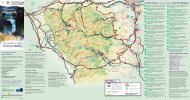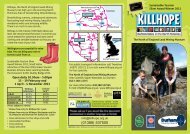How a visit to Killhope can inspire
How a visit to Killhope can inspire
How a visit to Killhope can inspire
You also want an ePaper? Increase the reach of your titles
YUMPU automatically turns print PDFs into web optimized ePapers that Google loves.
UNIT 4B: HABITATS<br />
Using <strong>Killhope</strong>: <strong>Killhope</strong> is the perfect venue for a study of habitats. At <strong>Killhope</strong> you <strong>can</strong> find<br />
reservoirs, streams, rivers, woodland, newly-planted woodland, the Washing Floor, grassy patches,<br />
shade, sunshine (sometimes!), and numerous other conditions that <strong>can</strong> be studied and compared.<br />
Our wildlife includes insects for children <strong>to</strong> collect and study, red squirrels, birds, rabbits, and pond<br />
life, as well as all the inhabitants of the river. <strong>Killhope</strong> also provides facilities make fieldwork more<br />
comfortable – <strong>to</strong>ilets and picnic tables. As an Area of Outstanding Natural Beauty, <strong>Killhope</strong> must<br />
also consider the effect of changes <strong>to</strong> habitats that children must begin <strong>to</strong> understand in this unit.<br />
LEARNING OBJECTIVES POSSIBLE ACTIVITIES LEARNING OUTCOMES<br />
Introduction<br />
• To review children’s prior<br />
knowledge and<br />
understanding.<br />
• To give an overview of the<br />
unit.<br />
• To identify different types<br />
of habitat.<br />
• That different animals are<br />
found in difference<br />
habitats.<br />
• To make predictions of<br />
organisms that will be<br />
found in a habitat.<br />
• To observe the conditions<br />
in a local habitat and make<br />
a record of the animals<br />
found.<br />
• That animals are suited <strong>to</strong><br />
the environment in which<br />
they are found.<br />
• To group organisms<br />
according <strong>to</strong> observable<br />
features.<br />
• Ask the children about the<br />
difference between ‘plant’ and<br />
‘animal’, using examples found<br />
on site. Ask the children <strong>to</strong> sort<br />
them and explain their criteria.<br />
Finding different habitats<br />
• Introduce the children <strong>to</strong> the<br />
word ‘habitat’. Take a walk<br />
around <strong>Killhope</strong> <strong>to</strong> identify the<br />
different habitats – the river, the<br />
reservoirs, the woodland, the<br />
Washing Floor, grassy patches,<br />
fields, under leaf, under s<strong>to</strong>ne,<br />
walls. Ask the children <strong>to</strong> group<br />
habitats and record them.<br />
Different animals in different habitats<br />
• Ask the children <strong>to</strong> predict where<br />
particular animals will be found<br />
on site, eg woodlice, snails,<br />
squirrels. Watch the rabbits and<br />
red squirrels at the hide. Help<br />
the children <strong>to</strong> collect<br />
invertebrates and record<br />
locations. Ask the children <strong>to</strong><br />
observe the conditions they were<br />
collected in, eg light, water, soil,<br />
shade, and see if it is what was<br />
expected. Return the animals <strong>to</strong><br />
their habitat.<br />
Grouping living things<br />
• Present children with some<br />
animals collected on site,<br />
including similar pairs and<br />
discuss features. Ask children <strong>to</strong><br />
group them and explain their<br />
groupings.<br />
• To have sorted plants<br />
and animals found on<br />
site according <strong>to</strong> the<br />
children’s own criteria.<br />
• Identify local habitats<br />
and recognise those<br />
which are similar in<br />
scale or diversity.<br />
• Make and justify a<br />
prediction.<br />
• Describe a habitat in<br />
terms of the<br />
conditions.<br />
• State that animals and<br />
plants are found in<br />
some places and not<br />
in others and explain<br />
why.<br />
• Identify similarities and<br />
differences between<br />
similar organisms.<br />
• Group animals and<br />
explain criteria on<br />
which the groups are<br />
based.<br />
•<br />
44







